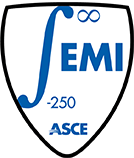Intelligent Sensing for Structural Health Monitoring
University of Michigan
Problems
Civil infrastructure systems have been successful in supporting the economic prosperity of our nation. However, several serious issues must be urgently addressed to ensure our infrastructure can continue to support societal prosperity and ensure public safety. Foremost among the challenges is the problem of aging infrastructure. Today, many infrastructure systems are rapidly approaching the end of their intended design lives. Annual evaluation of our nation's infrastructure systems by ASCE cites dismally poor "grades" for almost all infrastructure types. Furthermore, many of these aging infrastructure systems remain vulnerable to natural hazards (e.g., earthquakes, hurricanes). A number of recent natural catastrophes have revealed the need for improved design standards and means of rapidly assessing infrastructure health post‐event. Fortunately, recent advances in sensing now make it possible to densely instrument the built environment in order to observe the behavior and health of civil infrastructure systems.
Approach
Our group pioneers new sensing technologies that are specifically designed for the monitoring of civil infrastructure systems. In particular, our efforts can be delineated into three major thrust areas: 1) wireless sensors for structural health monitoring (SHM); 2) information technologies for data mining and decision support; 3) system identification and damage detection. Wireless sensors represent a disruptive technology for the structural monitoring field due to their low‐cost and enhanced functionality. The eradication of wiring between sensors and a data acquisition system dramatically pushes the cost of wireless sensors to be one order of magnitude lower than that of wired counterparts. Wireless sensors also include computational resources unavailable in wired sensors. Our work explores the embedment of data interrogation algorithms in wireless sensors to allow them to process their own data. To implement complex engineering algorithms on this light‐weight computing platform, our approach decomposes algorithms into smaller computational blocks that can be distributed across a network of wireless sensors acting in a coordinated and parallelized manner. Algorithms specific to modal analysis, damage detection, and system identification have all been explored for embedment. To address the issue of managing large tracts of sensor data possible from large structures, our team has created a scalable database architecture upon which physics‐based and data‐driven analytical tools intended to extract physical meaning from monitoring data can be implemented. Specifically, automated data mining tools for modal parameter extraction, finite element model‐updating, and damage detection based on statistical pattern recognition have been successfully implemented.
Findings
Our team has recently deployed a permanent wireless monitoring system on the New Carquinez Suspension Bridge (Vallejo, CA) that employs 30 Narada wireless sensors collecting over 60 channels of bridge response data including the acceleration of the bridge deck and towers, deck displacements, wind speed, wind direction and temperature. Data stored in the database system is autonomously analyzed to extract statistical measures of bridge behavior and to calculate bridge mode shapes using stochastic subspace identification (SSI). In place since 2009, this long‐term bridge monitoring study reveals the accuracy and reliability of wireless sensing technology in harsh operational conditions.
Impact
The overall goal of this research is to create new paradigms in how the civil engineering profession can sense and analyze the behavior and health of infrastructure systems. Our emphasis is on providing both the data and interrogation tools necessary to empower the decision maker. In the future, informed decisions will be based on quantitative evidence of structural behavior as opposed to qualitative information obtained visually.
Core competencies
- Advanced sensing technology for structural health monitoring of civil structures
- In-network data processing using “smart” wireless sensor networks
- Multifunctional materials for direct and distributed damage sensing
- Vehicle-bridge interaction analysis
- System identification of dynamic systems
Current research team members
- Jerome P. Lynch (PI)
- Courtney Peckens (Ph.D. Candidate)
- Michael B. Kane (Ph.D. Candidate)
- Jeffrey Bergman (Ph.D. Candidate)
- Sean O'Connor (Ph.D. Candidate)
- Chun Lo (Ph.D. Candidate)
- Devki Desai (Ph.D. Candidate)
- Yilan Zhang (M.S. Student)
Recent graduates and co‐workers
- R. Andrew Swartz, Assistant Professor, Michigan Technological University
- Kenneth J. Loh, Assistant Professor, University of California‐Davis.
- Yang Wang, Assistant Professor, Georgia Institute of Technology.
Current research collaborations
- Chuck Farrar, Los Alamos National Lab
- C. H. Loh, National Taiwan University
- C. B. Yun and Hoon Sohn, KAIST
- Mohammed Ettouney, Weidlinger Assoc.
- Abbas Emami & Alex Krimotat, SC Solutions


